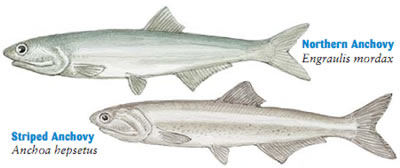Anchovies
Similar in appearance, these anchovies differ mostly in range, although the northern anchovy can be slightly longer. The northern anchovy is one of the most important forage fish in the Pacific and is used as bait for tuna and other large gamefish. A minor percentage of northern anchovies harvested are processed for human consumption, marketed in pickled or salted forms. The striped anchovy is also an important forage fish for game species, although it is too small and fragile to be used often for bait.
Identification
Anchovies are silvery fish that look like miniature herring. They have overhanging snouts and long lower jaws that extend behind the eyes. The striped anchovy has a ribbonlike stripe along each side and some yellow about the head. Anchovy species are difficult to differentiate, but the fin rays and the pattern of pigmentation on the striped anchovy distinguish it; it has 14 to 17 dorsal fin rays, 15 to 18 pectoral fin rays, and 20 to 24 anal fin rays, as well as melanophores outlining all its dorsal scales.Size
The northern anchovy can reach 9 inches, although 4 to 5 inches is more common; the striped anchovy can reach 6 inches, but the average length is less than 4 inches. |  |
Life history/Behavior
Northern anchovies spawn through the year, although they do so mainly in the winter and the early spring. Spawning occurs in nearshore and offshore environs, predominantly in depths of less than 33 feet and in temperatures of 50° to 55°F. Striped anchovies spawn from April through July in harbors, estuaries, and sounds. The eggs of both species are elliptical and float near the surface, hatching within a few days after being released. The young mature in 3 to 4 years.Food
Both anchovies feed on plankton.Other Names
Northern Anchovypinhead, North Pacific anchovy, California anchovy, bay anchovy; French: anchois du Pacifique nord, anchois de California; Spanish: anchoveta de California, anchoa del Pacifico.
Striped Anchovy
broad-striped anchovy; French: anchois rayé; Spanish: anchoa legìtima.

0 Response to "Anchovies"
Post a Comment